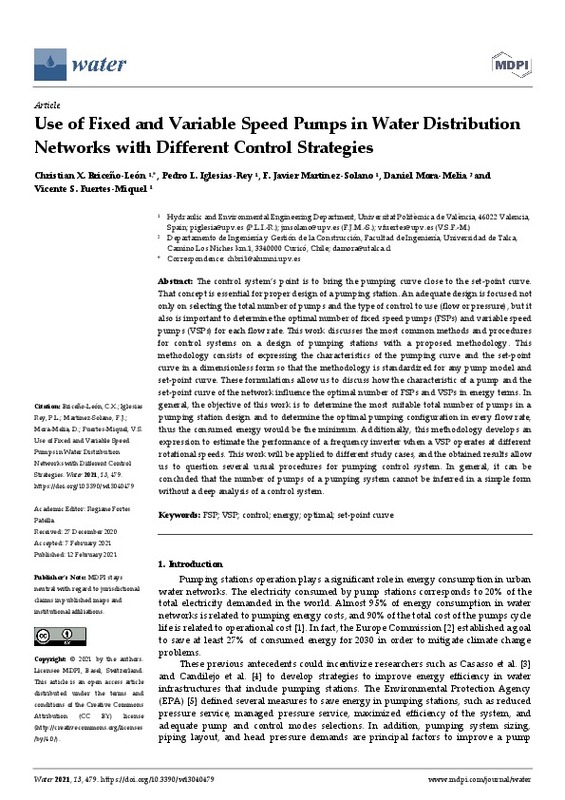JavaScript is disabled for your browser. Some features of this site may not work without it.
Buscar en RiuNet
Listar
Mi cuenta
Estadísticas
Ayuda RiuNet
Admin. UPV
Use of Fixed and Variable Speed Pumps in Water Distribution Networks whit Different Control Strategies
Mostrar el registro sencillo del ítem
Ficheros en el ítem
| dc.contributor.author | Briceño-León, Christian X.
|
es_ES |
| dc.contributor.author | Iglesias Rey, Pedro Luís
|
es_ES |
| dc.contributor.author | Martínez-Solano, F. Javier
|
es_ES |
| dc.contributor.author | Mora-Melia, Daniel
|
es_ES |
| dc.contributor.author | Fuertes-Miquel, Vicente S.
|
es_ES |
| dc.date.accessioned | 2022-01-27T19:03:22Z | |
| dc.date.available | 2022-01-27T19:03:22Z | |
| dc.date.issued | 2021-02 | es_ES |
| dc.identifier.issn | 2073-4441 | es_ES |
| dc.identifier.uri | http://hdl.handle.net/10251/180297 | |
| dc.description.abstract | [EN] The control systems point to bring the pumping curve close to the set-point curve. That concept is essential for proper design of a pumping station. An adequate design is not only focused to select the total number of the pumps and select the type of control to use (flow or pressure), but also is im-portant to determine the optimal number of Fixed Speed Pumps (FSP) pumps and Variable Speed Pumps (VSP) pumps for each flow rate. This work will discuss the most common methods proce-dures for control systems on a design of pumping stations with a methodology that it is going to be proposed. This methodology consists on expressing the characteristics of the pumping curve and the set-point curve in a dimensionless form so that the methodology be standardized for any pump model and set-point curve. These formulations allow us to discuss how the characteristic of a pump and the set-point curve of the network influence to determine the optimal number of FSPs and VSPs in energy terms. In general, the objective of this work is to determine the most suitable total number of pumps in a pumping station design and determine the optimal pumping configuration in every flow rate, so the consumed energy be the minimum. Also, this methodology will develop an ex-pression to estimate the performance of a frequency inverter when a VSP operates at different ro-tational speeds. This work will be applied to different study cases and the obtained results allow us to question several usual procedures for pumping control system. In general, it can be concluded that the number of pumps of a pumping system cannot be inferred in a simple form without a deep analysis of a control system. | es_ES |
| dc.description.sponsorship | This research was funded by the Program Fondecyt Regular, grant number 1180660. | es_ES |
| dc.language | Inglés | es_ES |
| dc.publisher | MDPI AG | es_ES |
| dc.relation.ispartof | Water | es_ES |
| dc.rights | Reconocimiento (by) | es_ES |
| dc.subject | FSP | es_ES |
| dc.subject | VSP | es_ES |
| dc.subject | Control | es_ES |
| dc.subject | Energy | es_ES |
| dc.subject | Optimal | es_ES |
| dc.subject | Set-point curve | es_ES |
| dc.subject.classification | MECANICA DE FLUIDOS | es_ES |
| dc.title | Use of Fixed and Variable Speed Pumps in Water Distribution Networks whit Different Control Strategies | es_ES |
| dc.type | Artículo | es_ES |
| dc.identifier.doi | 10.3390/w13040479 | es_ES |
| dc.relation.projectID | info:eu-repo/grantAgreement/FONDECYT//1180660/ | es_ES |
| dc.rights.accessRights | Abierto | es_ES |
| dc.contributor.affiliation | Universitat Politècnica de València. Departamento de Ingeniería Hidráulica y Medio Ambiente - Departament d'Enginyeria Hidràulica i Medi Ambient | es_ES |
| dc.description.bibliographicCitation | Briceño-León, CX.; Iglesias Rey, PL.; Martínez-Solano, FJ.; Mora-Melia, D.; Fuertes-Miquel, VS. (2021). Use of Fixed and Variable Speed Pumps in Water Distribution Networks whit Different Control Strategies. Water. 13(4):1-23. https://doi.org/10.3390/w13040479 | es_ES |
| dc.description.accrualMethod | S | es_ES |
| dc.relation.publisherversion | https://doi.org/10.3390/w13040479 | es_ES |
| dc.description.upvformatpinicio | 1 | es_ES |
| dc.description.upvformatpfin | 23 | es_ES |
| dc.type.version | info:eu-repo/semantics/publishedVersion | es_ES |
| dc.description.volume | 13 | es_ES |
| dc.description.issue | 4 | es_ES |
| dc.relation.pasarela | S\431734 | es_ES |
| dc.contributor.funder | Fondo Nacional de Desarrollo Científico y Tecnológico, Chile | es_ES |
| dc.subject.ods | 06.- Garantizar la disponibilidad y la gestión sostenible del agua y el saneamiento para todos | es_ES |
| dc.subject.ods | 07.- Asegurar el acceso a energías asequibles, fiables, sostenibles y modernas para todos | es_ES |
| dc.subject.ods | 09.- Desarrollar infraestructuras resilientes, promover la industrialización inclusiva y sostenible, y fomentar la innovación | es_ES |
| dc.subject.ods | 13.- Tomar medidas urgentes para combatir el cambio climático y sus efectos | es_ES |








